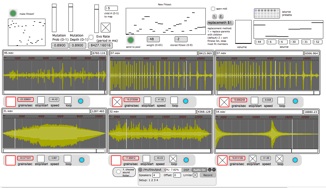Performance works


CIE is currently offering a number of collaborative group works for performance including:
Impulsions (2012) - Phil Edelstein
Performers: 2-5
Duration: 15-30 min.
A work where each performer prepares one or more impulse sound files that are shared as a common collection by the group. These impulse files are used as both sound sources and sound processors. Each performer modifies parameters such as rate of playback, repeat, rhythm, start and end points, frequency shift (of source or impulse), and adds any additional filtering and distribution in space.
••••••••
Speaking in Tongues (2012) – John Driscoll
Performers: 3-5
Duration: 25 min.
A work that uses a group of custom ultrasonic instruments designed by
John Driscoll with programming by Phil Edelstein. These instruments respond to almost microscopic amounts of physical movement and translate these movements into audible tones. Each instrument uses varying means of creating small-motion gestures from: a foil reflector on a spinning platter, to moving the lid of a plastic box, to foil reflectors mounted on springs and robotic control using Arduino micro-controllers and Wii Nunchucks.
••••••••
Mining Streams (2012) – Group Collaboration
Performers: 3-5
Duration: (30-40)
Mining Streams is a work that transforms various data streams as sound (interest rates, seismographic - volcanoes/earthquakes, sunspot activity
and weather). Performers sample the available data segments or fragments and process these audio signals in various ways including spatial distribution, pitch shifting, time-domain stretching, frequency spectrum manipulation, acoustical filtering and more. These signals are then put back into a “sound pool” for shared use by each performer and emerge as inter-fed signals that create sonic ghosts and echoes of one another.
••••••••
On-to-genesis (2012) - Doug Van Nort
Performers: 2-5
Duration: 10-20 min.
A piece for custom software instrument wherein each performer controls the evolution of an algorithmic process rather than the specifics of individual sound events. The underlying genetic algorithm controls the parameters of sound synthesis (e.g. granular and filtered noise) so as to shape the sound output over time.
The paradigm is that of networked performance in which the group collectively decides the overall rate, mutation probability and "fitness" of the process, while maintaining individualized control of certain sonic details related to dynamics and timbre. Thus, the process itself is sonified, as is the collective voice of the group.
The sound output from each performer is directed to a different location in the sound field, as closely localized to the performer as possible, so as articulate each member's unique sonic voice within the larger mass of sound.
Play Audio File
••••••••
Gold Standard (2006) – Tom Hamilton
Performers: 2-5
Duration: 6 min.
Gold Standard uses fluctuations in the price of gold, as represented by the historical data found in several monthly charts. Reversals in trends are used to determine onset and duration of sounds. Each player designs and performs on an electronic instrument that is heard from a unique location in the performance space.
Each player designs an electronic instrument with one basic sound. The control over this sound is a simple ON or OFF. The sound source should be capable of sustaining durations of 0.5 – 10 seconds.
Each instrument is played into a sound field of 2 or more channels. The direct sound of the instrument should be located at only one of the speakers, but the sound field should suggest a larger and imaginary space. The composite mix should feel like each performer’s sound originates from a different location, with the individual unique echoes and reverberations audible to the listener.
Gold Standard is adapted here for CIE, and was originally developed for the 2006 Sound Symposium festival in St. John’s, Newfoundland, where it was performed on 4 ship’s horns as part of their Harbor Symphony series.
••••••••
Anecdotal Evidence (1992/2012) – Matt Rogalsky
Performers: 4
Duration: approx. 30 min.
Four performers open envelopes containing photographs they've never seen before. They simultaneously describe details of each photograph in turn (the audience does not see the images during this part of the performance). While they are speaking, custom software tracks the pitch and volume contours of their voices and stores this data. Occasionally, their voices trigger small electronic "ornaments" which hang upon the spoken-word descriptions.
When the performers have described all of their photographs, they sit down and the recorded data is then used as raw material for an improvisation while the photographs are sequentially projected. The performers are free to use the data in any way they choose.
Play Audio File
••••••••
Fractology (2012) – Phil Edelstein
Performers: unlimited
Duration: approx. 4-40 min.
Performers acoustically navigate a combine chaotic landscape looking for motion and balance. The landscape is one of turbulence, vortex, precipices and voids, folds and singularities. The performers must contend with fractious synthetic objects that present a guarantee of structured uncertainty.
The performers are responsible for tickling sonic behavior from qualitative descriptions and quantitative abstractions that start without a sonic body.
Fractology Images
••••••••
Technical Requirements (Sponsor):
• 4 channel sound system (min. 100W/channel)
• Performers tables with AC strips
• Spot lighting
-
•Video Projector/Screen
-
•(4) Mic Stands

CIE Home | Current Activities | Past Concerts | Projects | CIE History | People |
| Focused Sound Fields | Focused Loudspeakers |





